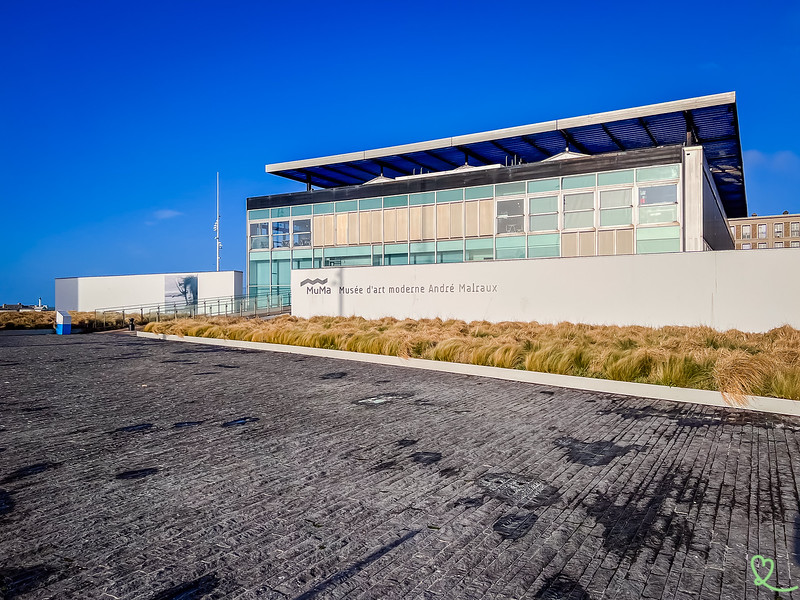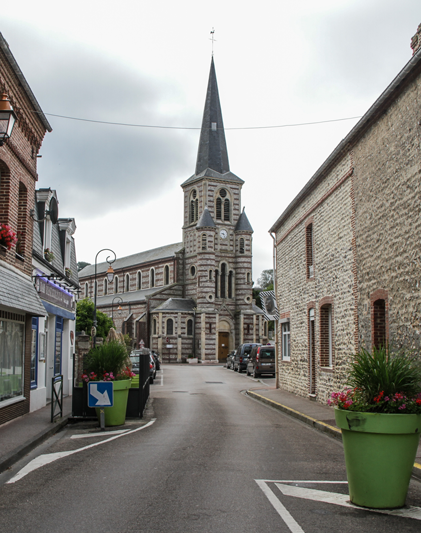For us, the MuMa, Musée d’Art Moderne André Malraux in Le Havre, is one of the most captivating and fascinating museums in Normandy.
Facing the sea, it offers a dialogue between the painters’ works and the incomparable beauty of the Normandy skies and lights that so inspired the Impressionists.
In this article, we’ll give you all the information you need to make your visit a success, along with plenty of photos to help you make up your own mind.

This review is completely independent, we visited anonymously and paid our admission in full.
Why visit the MuMa Musée d’art moderne André Malraux?
Is the MuMa Musée d’art moderne André Malraux worth it? Our opinion:
Whether you’re an art lover or not, the MuMa is well worth a visit:
- for the unique setting and atmosphere of this museum, which faces the entrance to the port of Le Havre, an invitation to escape;
- for the highly innovative architecture of this building, with its lack of load-bearing walls and large expanses of glass, which plays so well with light;
- for the richness of its collections, one of the finest in France for Impressionist and Fauvist painters.
This is one of Le Havre’s must-see places.

Why is MuMa Musée d’art moderne André Malraux famous?
The MuMa’s reputation stems from both its symbolic dimension and its collections.
Destroyed during the bombing raids that wiped out 82% of the city in September 1944, it was the first museum to be rebuilt after the war. It symbolizes the triumph of art over barbarism, and heralds a much more open, protean and vibrant culture! Under the impetus of writer and General de Gaulle’s Minister of Culture, André Malraux, the term “museum – Maison de la Culture” was coined for a number of years, reflecting this major evolution in the relationship between the arts and their public.

A city of painters and wealthy collectors, Le Havre has benefited from numerous legacies, both from the families of artists from Le Havre and Normandy (Dufy, Boudin…) and from major collectors who traded in Le Havre (Charles-Auguste Marante, Olivier Senn…). Today, the Muma boasts one of France’s finest collections of Impressionist and Fauvist painters.
Living just a few hundred meters away, we’ve been faithful visitors since our earliest childhood (which is getting a little old…).
And if you’re only here for a day on your cruise, don’t miss it!
USE OUR GUIDE TO PLAN A
DREAM TRIP TO Normandy
All the information you need for your trip:
- 8 maps that make planning easier
- 160+ pre-selected locations
- Practical advice
- 300+ photos to help you choose

History in brief
- August 25, 1845: the Musée des Beaux-Arts du Havre is created, under the direction of French painter and lithographer Adolphe-Hippilyte Couveley. The museum now boasts 400 works.
- 1936: donation of 89 works, mostly Impressionist, by Charles-Auguste Marande, a wealthy Le Havre merchant.
- between September 5 and 10, 1944: the Musée des Beaux-Arts was completely destroyed by Allied bombing, but 1,500 of its works moved to the Prieuré de Graville were saved.
- 1951: the town decides to build a new building, entrusting it to architect Guy Lagneau, a graduate of the Beaux-Arts in Paris.
- June 24, 1961: André Malraux, General de Gaulle’s Minister of Culture and writer, inaugurates the museum.
- 1963: bequest from Madamde Dufy, widow of painter Raoul Dufy, of 65 works by the artist.
- 2004 : donation of 206 works from the collection of cotton merchant Olivier Senn by his granddaughter Hélène Senn-Foulds.
WHERE TO STAY IN Le Havre
Our favorites: neighborhoods and hotels
On the waterfront:
Hilton Hotel with its modern decor and balconies – see prices, photos and availability.
Downtown, in the heart of Perret architecture:
Hôtel Pasino, for ultra-spacious rooms – See prices, photos and availability
Hotel Vent d’Ouest, a charming place to stay – See prices, photos and availability

Practical tips and map MuMa Musée d’art moderne André Malraux,France
Where to find MuMa Musée d’art moderne André Malraux
- In downtown Le Havre, at the southern tip of the waterfront.
- 2 Bd Clemenceau, 76600 Le Havre
- From Town Hall: 5min by car, 20min on foot
How to get there
To get to Le Havre, you can choose between:
- By train: the town is linked to Rouen and Paris via an intercity train, with an average of 16 journeys a day, and you should allow around 2 hours 20 minutes. Plan ahead, as delays (although improving) are still common on this line since our childhood…
- Bus: regular bus services link Le Havre to Paris airports and several provincial cities. It will take between 2 and 3 hours, about the same as by train.
- By car: Le Havre is connected to 2 motorway networks, the A13 to Paris and the A29 to the north of France and Belgium, and the south-west of France.
See available timetables and book your train and coach tickets now.
Once you’ve arrived in Le Havre, a network of buses, streetcars and scooters will enable you to quickly reach the Muma and discover the city.
- By streetcar: Hôtel de Ville stop – then 15-minute walk
- By bus: line 7 – MUMA stop
OUR ADVICE FOR RENTING A CAR IN Normandy
- Compare prices on our preferred platform: DiscoverCars – one of the best rated sites.
- Choose a car that is comfortable enough (distances can be long) but compact (some parking lots and villages are narrow).
- Think of thecomplete insurance (some roads are tortuous and narrow).
- There is a lot of demand, book it early.

Parking
The museum doesn’t have its own parking lot, but parking in the surrounding area is generally easy and free as long as you stay close to the waterfront. You can also opt for free parking at 105 boulevard Clémenceau, 200 meters from the museum entrance.
Best time to visit MuMa Musée d’art moderne André Malraux
The only peaks in visitor numbers are on rainy days and during the vacation season (mid-July to mid-August). Apart from these moments, you should be able to enjoy the exhibitions without too much difficulty.
As part of its role as a cultural center open to the city, the museum regularly welcomes school groups.
How long to visit the museum and main difficulties
We recommend that you allow between 1h and 1H30 to visit the André Malraux Museum, but you can extend the experience depending on your interest in the collections.
The museum is on a gentle slope, but accessible to wheelchair users. The only difficulty was getting there, as the ground was very bumpy. The building has toilets and lockers for your backpacks.

Advice on how to visit
The direction of the visit is quite obvious. The first floor is home to thetemporary exhibition, with some magnificent discoveries in recent years, including a series of exhibitions devoted to the secrets of Norman skies: winds, clouds…
The rest of the museum features collections spanning the 15th to 20th centuries, with a particular focus on Impressionism and Fauvism. The display is regularly revised to reflect the life of the collection: it’s a living museum!
MuMa Musée d’art moderne André Malraux with children
The MuMa does not have a specific tour for children, but its human scale and the accessibility of its works, particularly those of the Impressionists, make it a good introduction to visiting art museums.
Schedules and prices
Schedules
- Tuesday to Friday: 11 a.m. to 6 p.m.
- Saturday and Sunday: 11am-7pm
- MuMa closed on Mondays, January 1, May 1, November 11 and December 25.
Rates
- Full adult rate: €10
- Children: free under 26
- Special family rate: €6
Check the latest prices/times on the official website

Guided tours
- Guided tour of the temporary exhibition – Thursdays in summer at 11:30 am – booking essential – duration 45 minutes
- Bursting tour of the temporary exhibition – Sundays at 5.30pm – booking essential – duration 15 minutes
Catering
The MuMa has its own restaurant, “Les fauves” (in reference to the appetite, but also to the 3 great Le Havre painters (Dufy, Braque and Otton-Friesz) of Fauvism). It offers elaborate cuisine, blending local produce with just the right amount of creativity. The room overlooks the entrance to the port of Le Havre, a rare commodity in our city.

Architecture: the temple of light
Anyone who knows Le Havre knows that the weather can be changeable, offering striking contrasts from one hour to the next. This is due to the westerly winds that carry clouds and sea spray relentlessly, leaving the sunlight to shine intermittently.
The architects decided to make this constraint the signature of the MuMa’s architecture.

Perret or not Perret?
The MuMa site is one of the few buildings not to bear the signature of the architect who rebuilt Le Havre, Auguste Perret. There’s no apparent reinforced concrete or geometric pattern here, unlike all the surrounding buildings. The building is one of the few architectural breaks in the city center.

In fact, it was a former student of Perret’s, Guy Lagneau, who, after a violent break with his master, won the contract to build the museum. He wanted to move towards a brighter style of architecture, inspired by the work of the most famous French architect of the 20th century, Le Corbusier.
He was assisted in his work by his future partners, Michel Weill and Jean Dimitrijevic (LWD), as well as by Jean Prouvé, one of the great architect-designers of the 20th century, who brought them his mastery of aluminum, but we’ll come back to that later.
A temple of culture
With its ambition to break down the barriers between art andculture, and to turn museums into true cultural centers open to all forms of culture, it was necessary to build a highly flexible space. While this may seem commonplace today, anyone who has visited France’s great museums knows that the compartmentalization of eras, painters and styles used to be the rule.

With no load-bearing walls, the structure is a huge cube that now boasts a surface area of 4,580m2 spread over 3 levels, with almost infinite flexibility!
All 5 sides of the building are open to the outside, with no less than 550 m2 of glazed surfaces!
Mastering light
We’re facing the sea, exposed to sea spray and sudden changes in light… in a building that’s largely open-plan… surrounded by huge windows… and this building is designed to house fragile works that require optimum lighting conditions to be admired! Quite a challenge, don’t you think?
It would take all the genius of the post-war period to put an end to it:
- to the east, opal glass filters the sun’s rays
- to the south and west, Jean Prouvé added pivoting aluminum shutters with screen-printed glass
- the roof is covered with a paralume, a system of aluminum blades that transforms the sun’s fiery rays into soft light. This too is a Jean Prouvé design.

The result is striking, and lends the museum an atmosphere like no other.
Depending on when you visit the museum, you may be lucky enough to witness a beautiful sunset with one of our region’s magnificent skies. All this while contemplating works of art, particularly Impressionist ones, inspired by these landscapes and lights. Just magical!
But what’s this sculpture?
In front of the museum, you can’t miss “Le Signal”, a monumental sculpture 22 metres long, 7 metres high and weighing over 220 tonnes. Note that it can maintain its balance by being hollow on the inside.

It is the first monumental work byHenri-Georges Adam, a French non-figurative engraver-sculptor also known for his contemporary tapestries. He signed his sculpture on completion in 1961.
The interpretation of this work remains open to question, with many Le Havre residents seeing an eye, others a compass, and some opting for a futuristic shuttle that could have inspired the ships in Star Wars!
But isn’t it part of the nature of art to leave the viewer some room for interpretation?
Le Havre, painters and collectors
Le Havre has the dual advantage of being at the heart of a region, Normandy, which saw the birth of the great Impressionist artistic movement, and of having, through its port activity, welcomed a number of wealthy merchants.
Along with Sainte-Adresse, it was one of the first seaside resorts to host the entire French and even international cultural scene in the late 19th century.
It is this incredible combination that makes the Muma’s collections so rich today.
Le Havre, a city of painters
The birth of the Impressionist movement
Supported by the first curator of the Musée des Beaux-Arts, the painter Eugène Boudin, who arrived in Le Havre at the age of 10, gradually broke away from the dominant schools and contributed to the emergence of the Impressionist movement in the mid-19th century.

It was he who, from 1862 onwards, led Claude Monet, considered the inventor of Impressionism, to leave his studio and populate his works with the richness of Normandy’s landscapes and skies, whether in Le Havre or Honfleur.

In the years that followed, all the great names of Impressionism painted Le Havre and the surrounding area: from Pissaro to Sisley, via Jongkind!
As much as we love our city, far be it from us to suggest that Le Havre is the unique cradle of Impressionism, but it was undeniably one of its nurseries. By the way, if you’d like to find out more about Eugène Boudin, don’t hesitate to read our article on the Eugène Boudin Museum in Honfleur.
The birth of the fauve movement
Le Havre was also unique in witnessing the birth of a second movement, Fauvism. This time, it was on the initiative of Le Havre painter Raoul Dufy that Matisse and Marquet went to Le Havre and contributed to the emergence of this new movement that placed color at the center of the work.
Georges Braques and Ohton Friesz, 2 other artists born in Le Havre, were key players, contributing to the city’s artistic renown.

It was Raoul Dufy, however, who was most influenced by Le Havre, painting the beach at Sainte Adresse on numerous occasions, before turning away to the landscapes of southern France and moving on to Cubism.
Painters’ donations
Le Havre painters and their descendants have continued to enrich the museum’s collections. Among the most emblematic are..:
- 1990: donation of 224 sketches by Louis Boudin, Eugène Boudin’s brother
- 1963: Raoul Dufy’s widow donates 70 works by her husband

Le Havre, a city of collectors
As a port city, Le Havre benefited from the economic development of trade, driven in the early 20th century by the French colonial empire. It was at this time that artists, notables and merchants came together in the cercle de l’art moderne, which aimed to “popularize” new artistic trends in painting, of course, but also in music (Ravel, Debussy…).
The legacy of Charles-Auguste Marande
This wealthy cotton merchant of Alsatian origin, based in Le Havre, donated his private collection to the City of Le Havre on his death in 1936. A total of 89 works (by Renoir, Monet, Marquet…) will form the basis of the Musée des Beaux-Arts du Havre’s Impressionist and Fauvist collection.
The Hélène Senn-Foulds donation
It wasn’t until 2004 that the granddaughter of art dealer Olivier Senn donated her exceptional collection of 206 works to the MuMa.

This Swiss-born lawyer, born in 1864, made his fortune with the Compagnie Cotonnière. He began acquiring pieces as early as 1900, building up one of the most coherent private collections of its kind, covering the different currents of this fertile period (Impressionist, Neo-Impressionist, Romantic, Fauvist, etc.).
Frequently asked questions
Why MuMa?
For “Mu “sée “Ma “lraux. André Malraux was a writer and France’s first ever Minister of Culture under the presidency of General de Gaulle.
Originally the Musée des Beaux-Arts du Havre, it became the Musée Malraux in 1999 and the MuMa in 2011.
Not to be confused with its very prestigious phonic neighbor, “MoMa”, the Museum of Modern Art in New York.
PLAN YOUR TRIP TO Normandy
Inspiration destinations
- Deciding where to go in Normandy – the best destinations
- Our weekend ideas: best-of, romantic, unusual, seaside, luxury, family
- 16 seaside hotels in Normandy
- The most beautiful charming hotels in Normandy

Best of

Practice
- Where to stay in Normandy – best places and hotels
- See our tips for renting a car at CDG airport, Orly airport, Beauvais airport, Caen, Rouen, Bayeux…





